This was published 9 years ago
Sri Lanka by train: A journey on a charmingly decrepit railway
A journey on one of the most charmingly decrepit railway systems in the world reinforces the maxim that all great travel involves a modicum of discomfort.
By Anthony Dennis
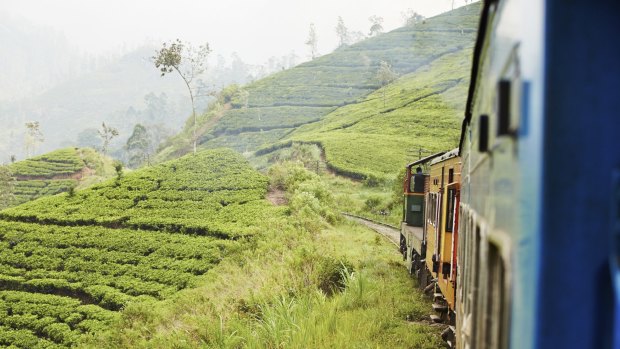
Hill view: A passenger train wends its way along tea-clad slopes.
At Colombo's Fort Station, the trapped tropical humidity inside the building's interior, a tangle of silver-coated wrought and corrugated iron straight out of the early 20th-century British colonial era, is intense. I feel like a chicken inside a pressure cooker, and probably look like one, as I await my train for the two-and-a-half-hour ride to Kandy.
I'm at the beginning of a 10-day journey around Sri Lanka. Such is the antiquated nature of the Sri Lankan railway network that here, in my perspired state, I wouldn't be surprised if a locomotive, spewing steam and nostalgia, drew into the platform. Soon enough my train, pulled by a diesel loco, arrives and I identify the carriage – the last – with the words "Observation Saloon" written on it.
I estimate that my carriage must date to 1930s or 1940s – the steam era, no less – the ceiling in the interior is polished teak replete with ineffectual vintage roof fans, while at the end of the carriage, the last, there's a big picture window with a crack running the length of it. But it's no revelation. Sri Lanka is home, after all, to one of the most charmingly decrepit railway systems in the world.
Yet compared to India's epic rail network, Sri Lanka's is like a toy train set, and all the better for it since the crowds are generally fewer and the journeys shorter and less arduous. Unlike India, it's not easy to construct a neat railway journey here since all of the lines are like varicose veins, extending from Colombo unconnected to the north, south and east, to a multiplicity of destinations.
But after having been literally stalled in its tracks due to a savage civil war that led to abject neglect, the Sri Lankan Railways are these days on a comparative roll. After a nearly 25-year hiatus, the Queen of Jaffna is due to resume services, linking the once war-ravaged Tamil-dominated north with the rest of the country. It's also nearly a decade since a tsunami careered onto a tranquil Sri Lankan coastline, killing 50,000 people including passengers on a crowded train travelling on a line, which will feature on my own journey, directly beside the palm-fringed beaches of the south-west corner of the so-called tear-drop island.
Sri Lanka's railway system, once known as the Ceylon Government Railway and a product of British colonial rule, can be traced to the mid-19th century. It includes some of the world's most scenic railway routes, as I am to discover on my journey around its most densely populated south-western corner. The route that I have devised (or is it contrived?) will take me from Colombo to Kandy and into the highlands, carpeted in tea plantations, across to the tows of Nuwara Eliya and onto Ella. Just beyond there, at Badula, the line runs out, ending in the jungle, and where it will be necessary for me to head south by road to Galle and then back to Colombo. Notably, the last leg will take me to the site of what, remarkably, remains the worst accident in railway history.
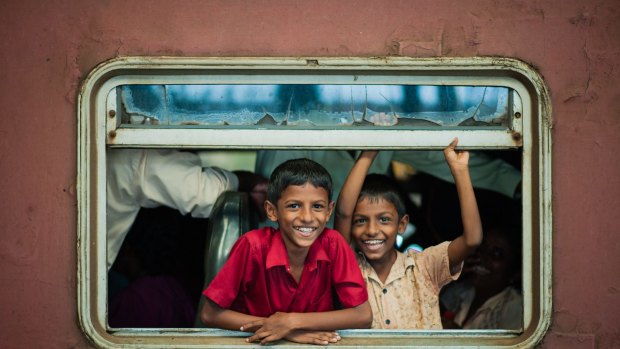
Children on a train in Sri Lanka.Credit: Alamy
TO THE UP-COUNTRY: COLOMBO TO KANDY
The train shakes, rattles and rolls its way through the scruffy suburbs of Colombo. Men on passing trains stand on the footboards of open doors perfectly framed next to signs reading: "Travel on footboards is a punishable offence." The more cashed-up tourists, rather than take the train in Sri Lanka, prefer to be driven, or to be more precise, be chauffeured around the island.
But most, if not all, great travel involves a modicum of discomfort. And I'm evidence of it, sitting on my weathered, torn upholstered "soft class" seat with the air trying to circulate with all the difficulty of a shy guest at a party who knows no one. One of the reassuring aspects of roughing it on the railways in Sri Lanka is that each night you can look forward to the comfort of a stay at one of the many splendid, relatively affordable colonial villas, transformed into luxury accommodation, and dotted across the island. I must confess that I have been provided a driver-guide following me around the island in a support vehicle of sorts, meeting and greeting me at my various stops.
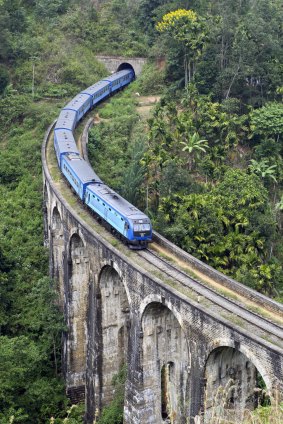
Rail tale: A modern passenger train swoops down over one of Sri Lanka's old bridges.
Unlike my crumpled self, I soon learn that one of the marvels of the Sri Lanka railways are the guards and conductors. It's not that they're particularly efficient. It's their dress-sense, resplendent, as they are, in crisp top-to-toe starched white uniforms, offset by black ties with clips and polished black shoes.
As such a sartorial conductor moves through the carriage checking tickets, lavish banana fronds flank the track as the train claws it way into the highlands, skirting along narrow terraces high above muddy rice paddies with the occasional splash of colour in the form of the blue and purple saris worn by local women toting white umbrellas strolling along paths to and from villages.
We pass stooped white-washed stupas right beside the track and risible train "speed detector" signs with the "tunnels" through which the train periodically trundles through little more than roughly hewn caves. The higher we go into the "up country", as the Sri Lankans like to call it, and the closer we get to Kandy, the thicker the vegetation and the lesser the humidity. I notice through the window crack'd that as soon as the train passes the track fills up with locals, including groups of monks in the obligatory saffron-tinted robes, who use it as a convenient thoroughfare, at least until the next train comes along.
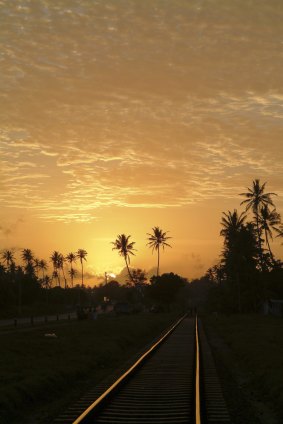
Westward-ho: A branch of the Sri Lankan railways heads into the sunset.
Kandy is Sri Lanka's holy capital and a city that is a little unfairly dismissed as, well, a hole. It is a city of hills which need to be fully explored to gain a full sense of a place beyond its main attraction, the Temple of the Tooth, where a molar of Budda is said to be kept. The temple was also the location in 1998, at the height of the civil war, of one of the Tamil Tiger's most audacious bombings in which its members drove an explosives-laden truck to the entrance where it was detonated. Seventeen people died. In such a devoutly religious country the act must have been the equivalent of bombing St Peter's in Rome.
A PLUNGE INTO THE PLANTATIONS: KANDY TO HATTON
After a few days in Kandy, a city as utterly different from its rival Colombo as Sydney is from Melbourne, I'm back on the train, pushing onto to Hatton, three hours or so away, and deep in the high-altitude tea country. Despite being synonymous with tea, Sri Lanka is only the fourth-biggest producer behind China, India and Kenya.
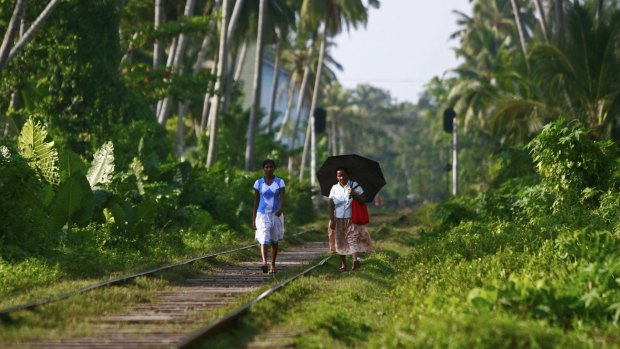
Short cut: Villagers use the rail tracks as pathways.
For this journey I'm in a modern, air-conditioned Chinese-built carriage climbing 500 metres from Kandy to about 2000m, the temperature dipping as we go. We pass laundry drying on a large pile of ballast for the track with terraced rice-fields in the distance and breeze through apricot-coloured hill stations where there's a seemingly ritual clapping of hands from guards and waiting passengers to welcome and farewell the non-stopping train.
Inside the train a hawker passes through the carriage, flanked by dense jungle, with a basket of peanuts as rain flecks the windows. "Tea flant, tea flant," shouts a little boy, struggling with his English pronunciation, as we rise to high enough altitude for the first of the tea plantations to materialise. "Tea plant, tea plant," an older boy in the carriage corrects the younger one.
There is indeed "tea flant" for as far as my eye can see but I remind myself that a century and a half ago this extraordinary agricultural landscape didn't exist since coffee propagation dominated to such an extent that Sri Lanka was, for a time, the world's biggest exporter. Then a leaf blight destroyed the crops – and the livelihood and lives of many colonial planters and their pickers – until the British sought an alternative in the form of tea. And it was coffee and tea that inspired the British – one of the island's myriad colonisers – to build railways deep into the hill country.
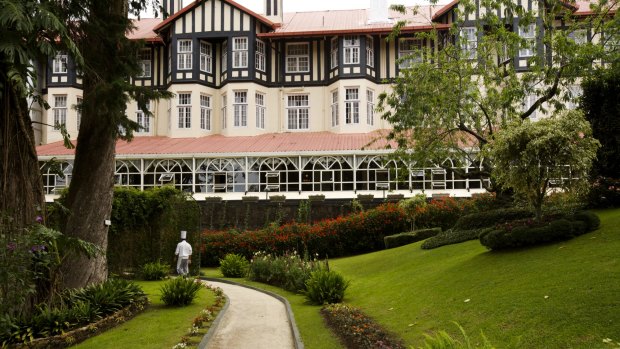
Colonial remains: The gardens of the English-style Grand Hotel at Nuwara, Eliya are a manicured delight.
As I gaze out the window, a thick mist has descended with the lights inside the carriage burning brightly, I can see hundreds of dark-skinned female Tamil pickers in colourful saris sprinkled across the plantations, like misshapen snooker balls on unflattened green felt. Now and again, as Bollywood films screen at either end of my first-class carriage, the gorgeous luminosity of the millions of shiny green leaves is broken by the occasional grand old planters homestead dating to the colonial days. While it's easy to romanticise the tea country the reality is that the Tamil pickers are effectively a poorly paid underclass and you won't see a single Sinhalese performing the back-breaking task of plucking leaves.
ACROSS THE TOP: HATTON TO NUWARA ELIYA AND ELLA
After a day or so in Hatton, staying one of the luxurious Tea Trails planter houses transformed into splendid accommodation by Dilmah Tea, which has cannily diversified into tourism, and hiking through tea plantations, I head by road to Nuwara Eliya, known as Sri Lanka's "Little England" with its rich stock of colonial buildings and stuffy hotels still faithful to the British trait for petty formality.
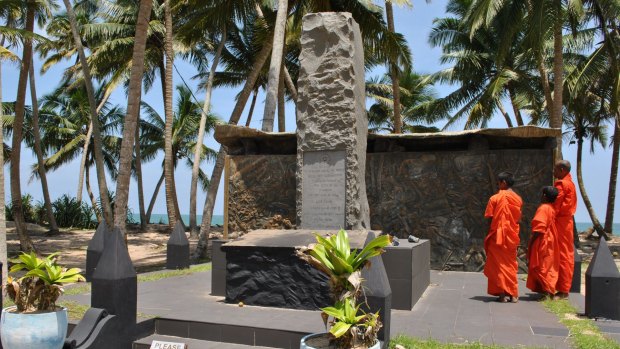
Trio's tribute: Monks visit the memorial to Sri Lanka's worst rail disaster.
Back on track, this time to Ella and then down to the coast to Galle, inside the carriage there's a festive air, as it's a public holiday weekend and Sri Lankans are seizing the opportunity for a break, as a group of friends sing and play drums. An elderly German couple across the aisle from me sit purse-lipped at the noise but eventually, even though it's feeling like being in the crowd of some T20 cricket match the clamour becomes a kind of soundtrack for the journey and all of the foreigners, me included, get into the spirit.
It appears that at least some of the young Sri Lankan passengers have never travelled in such a modern carriage since they don't know how to operate the automatic push-button sliding door at either end. The journey between Nuwara Eliya and Ella is regarded as one of the most beautiful in the world and while I can't disagree I've grown accustomed to the glorious aesthetics of this island.
The train, passing along the edge of mountains, reaching heights of 1400m, pops in and out of pockets of mist, blinding us to the spectacular view of tea factories clinging to hillsides and of the valleys far below us where tea gives way to other agriculture, until eventually we're enveloped by the fog. Tropical, seaside Colombo and its heat seems an eternity away.
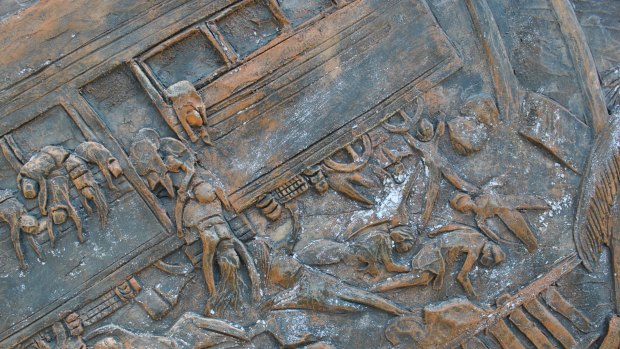
Tragic relief: A detail at the memorial site of the Sir Lanka's worst rail disaster, in 2004, when a tsunami struck.
Once I reach the slightly ramshackle mountain resort town of Ella, I spot my driver-guide in the waiting crowd outside the station and we head by car down the coast. The nearest railway line to the south is a short one between Matara and Galle and I'm determined to take it, if only to protect the integrity of my loop-like journey around the island. But time defeats us. Still?, the trip by car from the mountains to the coast is much longer than I had anticipated and we arrive at our accommodation, just outside Galle, late at night.
TRACKS TO TRAGEDY: GALLE TO COLOMBO
Galle, the walled Dutch-built coastal city dating to the 17th century and oozing charm, is a hard place to leave but I want to make a pilgrimage to the train crash site. Even though every window and door on the truly decrepit train I take from Galle Railway Station a relatively short distance up the coast is wide open inside it feels like the sort of sauna only a Finn could tolerate.
By the time we reach Telwatta, roughly at the site of the disaster, nearly an hour or so later, where I rendezvous with my driver-guide, I'm glad to get off but it's not the happiest of places at which to disembark a train.
Here, at 6.55am on December 26, 2004 the Queen of the Sea – so named because its route hugged the scenic south western coastline of Sri Lanka – departed Colombo on a routine journey to Galle. Aboard the packed train were as many as 1500 passengers. At 9.30am at the village of Peraliya, now literally erased from the map, the first of the tsunami waves from the earthquake that had earlier struck off the coast of Sumatra, Indonesia, swamped the Queen of the Sea. It was followed by a second massive watery tumult, fatally trapping passengers inside the overcrowded carriages and drowning those who managed to somehow extricate themselves. It's surely not just its shape that leads people to call this the teardrop isle.
During my visit I encounter a trio of Buddhist monks – a man and two teenage boys – visiting one of the memorials by the sea here. Standing between two tall palms, against a true turquoise sea, the man's orange robes provide a magnificent, yet faintly sickly contrast, to the ocean. The memorial features a bronze relief which uncompromisingly depicts the agony endured by the victims of the crash.
Elsewhere, across the road, I come across a piece of rusted iron, twisted like liquorice, sitting in a clump of overgrown grass. I conclude that it's a piece of old railway track contorted by the monumental force of tsunami. Nearby is a mammoth statue of Buddha, donated in 2005 by the Japanese as a memorial to the tsunami victims.
But a planned museum dedicated to the catastrophe sits half-built and empty awaiting an infusion of fresh funding from the Sri Lankan government. My visit to the disaster site is a sombre, yet somehow uplifting denouement to my journey around this remarkable, resilient island that is still wrestling with the ghosts of war and disaster. The since restored tracks that lead back to Colombo Fort Station, from where my journey began, strike me as steely symbols of hope for a country beset by exquisite tragedy.
Anthony Dennis is Fairfax Media's national travel editor. He travelled as a guest of the Classic Safari Company and Singapore Airlines.
FIVE TIPS FOR TAKING TRAINS IN SRI LANKA
1. Tour operators, such as the Classic Safari Company, can provide experienced driver-guides who will follow you by car as you travel by train. It allows you to travel without your luggage.
2. Many trains' doors don't align with station platforms. Passengers, rather than simply stepping off the train, have to climb down from it. It's something to consider if you have mobility issues.
3. On the coast, book a modern air-conditioned carriage as the heat can be stifling in the ancient and poorly ventilated carriages which are very gradually being phased out in favour of new rolling stock.
4. As in India, one of the pleasures of train travel is the colonial-era railway stations. Railway staff are extremely friendly and will allow you to pop into areas like ticket offices where the equipment and furnishings are like a time-warp.
5. Even though the trains can at times be uncomfortable, it's possible to break your journeys into relatively short legs. And, at the end of each trip, there's the reward of staying in some surprisingly affordable luxury villa accommodation across the island.
TRIP NOTES
MORE INFORMATION
GETTING THERE
Singapore Airlines operates daily flights from Sydney and Melbourne with convenient connecting services to Colombo. or Phone 13 10 11 or see singaporeair.com Australians must obtain an visa before arrival for a stay of up to 30 days (eta.gov.lk).
TOURING THERE
A 12-night, 13-day luxury Sri Lanka itinerary can include train travel as well as visits to destinations such as Thirappane, Sigiriya Kandy, Hatton, Galle and Colombo costs from $US6390 a person twin share. It includes a chauffeur-guide and private vehicle, luxury accommodation, all entrance fees to monuments, breakfast daily except at Ceylon Tea Trails where all meals are included. Phone Classic Safari Company 1300 130 218 or visit the website.
STAYING THERE
Tours with the Classic Safari Company can include a stay at the Galle Face Hotel, Colombo's most famous colonial lodgings. The hotel is undergoing a major renovation of its 150-year-old Classic Wing with all guests in the meantime accommodated at the more modern Regency Wing. See www.gallefacehotel.com
Sign up for the Traveller Deals newsletter
Get exclusive travel deals delivered straight to your inbox. Sign up now.